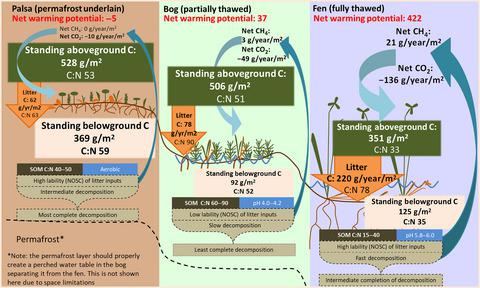当前位置:
X-MOL 学术
›
Glob. Change Biol.
›
论文详情
Our official English website, www.x-mol.net, welcomes your
feedback! (Note: you will need to create a separate account there.)
Coupling plant litter quantity to a novel metric for litter quality explains C storage changes in a thawing permafrost peatland
Global Change Biology ( IF 10.8 ) Pub Date : 2021-11-02 , DOI: 10.1111/gcb.15970 Moira Hough 1, 2 , Samantha McCabe 3 , S Rose Vining 2 , Emily Pickering Pedersen 4, 5 , Rachel M Wilson 6 , Ryan Lawrence 7 , Kuang-Yu Chang 8 , Gil Bohrer 9 , , William J Riley 8 , Patrick M Crill 10 , Ruth K Varner 7 , Steven J Blazewicz 11 , Ellen Dorrepaal 12 , Malak M Tfaily 2 , Scott R Saleska 1 , Virginia I Rich 2, 13, 14, 15
Global Change Biology ( IF 10.8 ) Pub Date : 2021-11-02 , DOI: 10.1111/gcb.15970 Moira Hough 1, 2 , Samantha McCabe 3 , S Rose Vining 2 , Emily Pickering Pedersen 4, 5 , Rachel M Wilson 6 , Ryan Lawrence 7 , Kuang-Yu Chang 8 , Gil Bohrer 9 , , William J Riley 8 , Patrick M Crill 10 , Ruth K Varner 7 , Steven J Blazewicz 11 , Ellen Dorrepaal 12 , Malak M Tfaily 2 , Scott R Saleska 1 , Virginia I Rich 2, 13, 14, 15
Affiliation

|
Permafrost thaw is a major potential feedback source to climate change as it can drive the increased release of greenhouse gases carbon dioxide (CO2) and methane (CH4). This carbon release from the decomposition of thawing soil organic material can be mitigated by increased net primary productivity (NPP) caused by warming, increasing atmospheric CO2, and plant community transition. However, the net effect on C storage also depends on how these plant community changes alter plant litter quantity, quality, and decomposition rates. Predicting decomposition rates based on litter quality remains challenging, but a promising new way forward is to incorporate measures of the energetic favorability to soil microbes of plant biomass decomposition. We asked how the variation in one such measure, the nominal oxidation state of carbon (NOSC), interacts with changing quantities of plant material inputs to influence the net C balance of a thawing permafrost peatland. We found: (1) Plant productivity (NPP) increased post-thaw, but instead of contributing to increased standing biomass, it increased plant biomass turnover via increased litter inputs to soil; (2) Plant litter thermodynamic favorability (NOSC) and decomposition rate both increased post-thaw, despite limited changes in bulk C:N ratios; (3) these increases caused the higher NPP to cycle more rapidly through both plants and soil, contributing to higher CO2 and CH4 fluxes from decomposition. Thus, the increased C-storage expected from higher productivity was limited and the high global warming potential of CH4 contributed a net positive warming effect. Although post-thaw peatlands are currently C sinks due to high NPP offsetting high CO2 release, this status is very sensitive to the plant community's litter input rate and quality. Integration of novel bioavailability metrics based on litter chemistry, including NOSC, into studies of ecosystem dynamics, is needed to improve the understanding of controls on arctic C stocks under continued ecosystem transition.
中文翻译:

将植物凋落物数量与凋落物质量的新指标相结合解释了解冻的永久冻土泥炭地中的 C 储存变化
永久冻土融化是气候变化的主要潜在反馈源,因为它可以推动温室气体二氧化碳(CO 2)和甲烷(CH 4)的释放增加。变暖导致的净初级生产力 (NPP) 增加,大气 CO 2增加,可以减轻解冻土壤有机物质分解产生的碳释放,和植物群落过渡。然而,对 C 储存的净影响还取决于这些植物群落的变化如何改变植物凋落物的数量、质量和分解率。基于凋落物质量预测分解率仍然具有挑战性,但一种有前途的新方法是将植物生物量分解对土壤微生物的能量有利性的测量纳入其中。我们询问了一种此类测量的变化,即碳的标称氧化态 (NOSC),如何与植物材料输入量的变化相互作用,从而影响解冻的永久冻土泥炭地的净 C 平衡。我们发现:(1) 解冻后植物生产力 (NPP) 增加,但它并没有增加站立生物量,而是通过增加对土壤的凋落物投入增加植物生物量周转率;(2) 尽管体积 C:N 比的变化有限,但植物凋落物的热力学有利性 (NOSC) 和分解率在解冻后均有所增加;(3) 这些增加导致较高的 NPP 在植物和土壤中更快地循环,导致较高的 CO分解产生的2和 CH 4 通量。因此,预期从更高的生产力中增加的碳储存量是有限的,而 CH 4的高全球变暖潜能值贡献了净正变暖效应。尽管由于高 NPP 抵消了高 CO 2释放,解冻后的泥炭地目前是碳汇,但这种状态对植物群落的凋落物输入率和质量非常敏感。需要将基于凋落物化学的新型生物利用度指标(包括 NOSC)整合到生态系统动力学研究中,以提高对持续生态系统过渡下北极碳库控制的理解。
更新日期:2022-01-05
中文翻译:

将植物凋落物数量与凋落物质量的新指标相结合解释了解冻的永久冻土泥炭地中的 C 储存变化
永久冻土融化是气候变化的主要潜在反馈源,因为它可以推动温室气体二氧化碳(CO 2)和甲烷(CH 4)的释放增加。变暖导致的净初级生产力 (NPP) 增加,大气 CO 2增加,可以减轻解冻土壤有机物质分解产生的碳释放,和植物群落过渡。然而,对 C 储存的净影响还取决于这些植物群落的变化如何改变植物凋落物的数量、质量和分解率。基于凋落物质量预测分解率仍然具有挑战性,但一种有前途的新方法是将植物生物量分解对土壤微生物的能量有利性的测量纳入其中。我们询问了一种此类测量的变化,即碳的标称氧化态 (NOSC),如何与植物材料输入量的变化相互作用,从而影响解冻的永久冻土泥炭地的净 C 平衡。我们发现:(1) 解冻后植物生产力 (NPP) 增加,但它并没有增加站立生物量,而是通过增加对土壤的凋落物投入增加植物生物量周转率;(2) 尽管体积 C:N 比的变化有限,但植物凋落物的热力学有利性 (NOSC) 和分解率在解冻后均有所增加;(3) 这些增加导致较高的 NPP 在植物和土壤中更快地循环,导致较高的 CO分解产生的2和 CH 4 通量。因此,预期从更高的生产力中增加的碳储存量是有限的,而 CH 4的高全球变暖潜能值贡献了净正变暖效应。尽管由于高 NPP 抵消了高 CO 2释放,解冻后的泥炭地目前是碳汇,但这种状态对植物群落的凋落物输入率和质量非常敏感。需要将基于凋落物化学的新型生物利用度指标(包括 NOSC)整合到生态系统动力学研究中,以提高对持续生态系统过渡下北极碳库控制的理解。











































 京公网安备 11010802027423号
京公网安备 11010802027423号